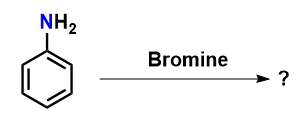
Electrophilic substitution of aniline with bromine gives.

(a) 1,4,6-tribromo aniline
(b) 2,4,6-tribromo aniline
(c) 4-tribromo aniline
(d) 3-tribromo aniline
Answer
220.5k+ views
Hint: The electrophilic substitution reaction involves the replacement of an atom by the attack of nucleophile. The nucleophiles are electron pair donor spaces such as \[{I^ - }\],\[O{H^ - }\]and \[C{N^ - }\]etc. The addition of an electrophile in electrophilic substitution occurs at electronically rich sites of the reacting species.
Complete Step by Step Solution:
Aniline is an organic compound, and it is a very important starting material in organic chemistry. It contains a phenyl group attached to the amino group (\[N{H_2}\]). Furthermore, it is also considered the simplest aromatic amine.
Aniline possess the following resonating structure (Image 1) in which the electron pairs are present ortho, and para positions i.e., aniline has electronically rich ortho, and para positions.
Image: Resonating structures of aniline showing the electronically rich ortho and para positions.
During the bromination of aniline, the bromine act as an electrophile (electron loving species) and it entered at electronically rich position i.e., ortho and para position of aniline. As a result, the formation of 2, 4, 6-tribromo aniline occurred (Image 2).
Image: Bromination of aniline.
From the above points it is cleared that option (b) will be the correct answer.
Note: It is to be noted both cyanide and isocyanide are two different functional groups. In cyanide, the reaction happens at the C atom, that is, bond formation takes place like (-CN). In isocyanide, the reaction happens at the N atom, that is, bond formation occurs as (R-NC).
Complete Step by Step Solution:
Aniline is an organic compound, and it is a very important starting material in organic chemistry. It contains a phenyl group attached to the amino group (\[N{H_2}\]). Furthermore, it is also considered the simplest aromatic amine.
Aniline possess the following resonating structure (Image 1) in which the electron pairs are present ortho, and para positions i.e., aniline has electronically rich ortho, and para positions.
Image: Resonating structures of aniline showing the electronically rich ortho and para positions.
During the bromination of aniline, the bromine act as an electrophile (electron loving species) and it entered at electronically rich position i.e., ortho and para position of aniline. As a result, the formation of 2, 4, 6-tribromo aniline occurred (Image 2).
Image: Bromination of aniline.
From the above points it is cleared that option (b) will be the correct answer.
Note: It is to be noted both cyanide and isocyanide are two different functional groups. In cyanide, the reaction happens at the C atom, that is, bond formation takes place like (-CN). In isocyanide, the reaction happens at the N atom, that is, bond formation occurs as (R-NC).
Recently Updated Pages
Difference Between Alcohol and Phenol: Structure, Tests & Uses

Classification of Drugs in Chemistry: Types, Examples & Exam Guide

Class 12 Chemistry Mock Test Series for JEE Main – Free Online Practice

Is PPh3 a strong ligand class 12 chemistry JEE_Main

Full name of DDT is A 111trichloro22bispchlorophenyl class 12 chemistry JEE_Main

Sodium acetate on heating with soda lime produce A class 12 chemistry JEE_Main

Trending doubts
JEE Main 2026: Application Form Open, Exam Dates, Syllabus, Eligibility & Question Papers

Derivation of Equation of Trajectory Explained for Students

Hybridisation in Chemistry – Concept, Types & Applications

Understanding the Angle of Deviation in a Prism

How to Convert a Galvanometer into an Ammeter or Voltmeter

Degree of Dissociation: Meaning, Formula, Calculation & Uses

Other Pages
Solutions Class 12 Chemistry Chapter 1 CBSE Notes - 2025-26

NCERT Solutions For Class 12 Chemistry Chapter 1 Solutions - 2025-26

The D and F Block Elements Class 12 Chemistry Chapter 4 CBSE Notes - 2025-26

NCERT Solutions for Class 12 Chemistry Chapter Chapter 7 Alcohol Phenol and Ether

NCERT Solutions ForClass 12 Chemistry Chapter Chapter 8 Aldehydes Ketones And Carboxylic Acids

JEE Advanced Marks vs Ranks 2025: Understanding Category-wise Qualifying Marks and Previous Year Cut-offs




